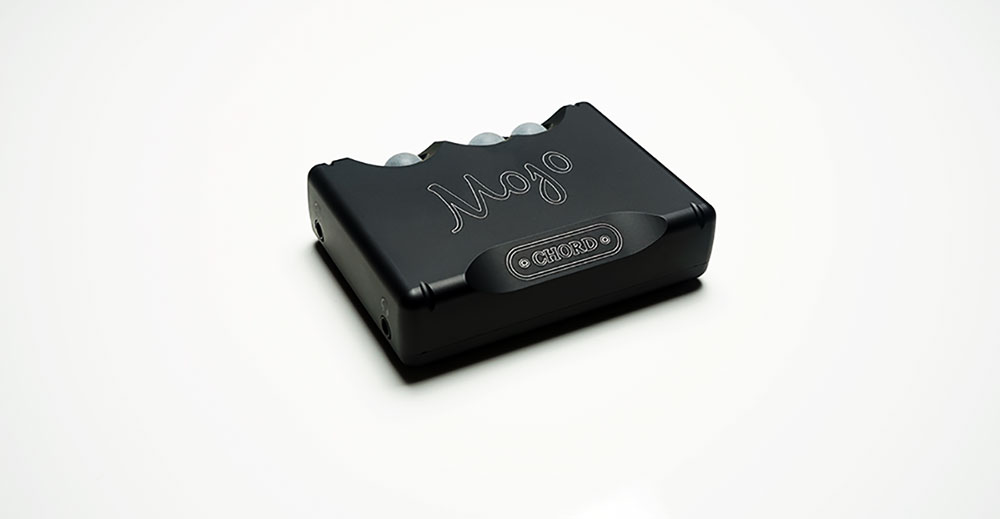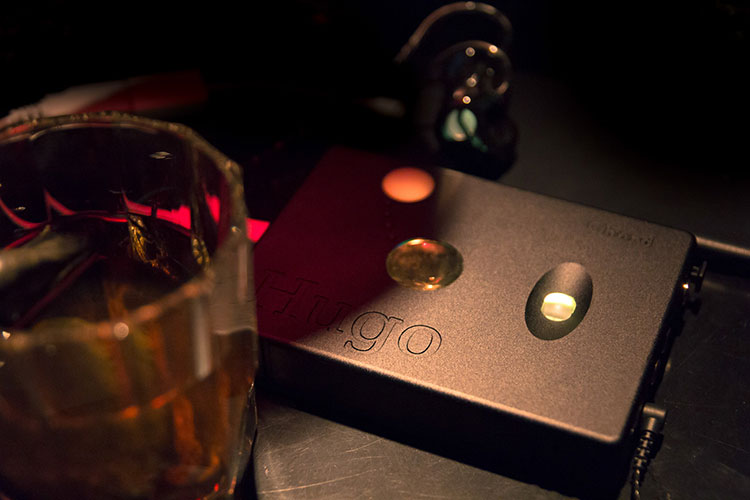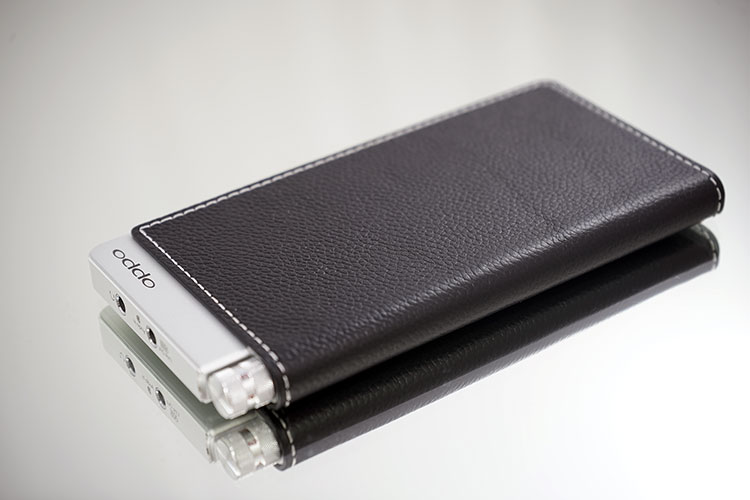Select Comparisons
Chord Electronics Hugo
Perhaps the obvious starting point given that Hugo laid the groundwork for the Mojo. It comes down to what you want from your DAC and how it should sound because the other differences are rather clear.
The Hugo costs three times the price of the Mojo. It is about 4 times the size and has the inputs and outputs that make it more of a system module than a portable amp/DAC. It can, however, become a portable Amp/DAC should you wish to use it in that manner. The Hugo also carries a wider range of accessories
Codecs
Note also the codec sampling rates favor the Mojo at present with the Mojo capable of 44kHz to 768kHz PCM and DSD64, DSD128, and DSD256 whereas the Hugo stops at 384KHz and support both DSD64 and DSD128 but not DSD256.
It would seem the Mojo is the better deal sampling-wise at present, but do remember FPGA, being what it is, I am sure Hugo can easily upgrade the DAC potential in the Hugo should there be a need. Right now there really isn’t a huge amount of DSD256 floating around.
Note also the Hugo can connect to both iOS and Android as well as desktop systems via both SD and USB, optical and Coaxial. It can also output the same digital and analog converted signal giving it a clear system edge over the Mojo.
Battery
The portability crown clearly goes to the Mojo with regards to size and usability as well as sampling rates at the time of writing. Interestingly though the battery rating on the Hugo exceeds that of the Mojo by around 2 hours on paper (8-10 hours for the Mojo and 12 hours for the Hugo).
I did not expect that given the purpose of the Mojo as a truly portable device but real-life usage among owners seems to suggest that anywhere between 6-10 hours is more likely and, truth be told, I didn’t get anywhere near 12 hours during review time. Ultimately, battery life depends on how you wish to use the Hugo.
Tonality
Tonally Hugo has an edge in terms of clarity, resolution, and detail retrieval. It is the analytical one, the “correct one”, but also the less musical one and the less forgiving one.
The Hugo is brighter and more neutral than the smoother and fuller-sounding Mojo. Truthfully I can live with both and there are times I would want one over the other depending on what music I am playing or what mood I might be in.
Artists such as Johnny Cash and his 90’s American Recording collection with its sparse acoustic tones and fantastically gruff Cash vocals play out better on the Hugo for me 90% of the time but on certain instances when the accompanying piano burst hit the low registers it sounds that bit more emotional and musical with the Mojo.
Switch over to something completely different such as Jane’s Addiction’s The Great Escape Artist (2011) and the Mojo starts becoming a slightly more engaging choice.
Once again I have to emphasize that technically Hugo has the edge over the Mojo. It is not night and day but it is there, particularly in staging qualities, width, and height.
What the Mojo has is a bit of a smoother approach with a fuller sound that really suits edgy arena rock such as Jane’s Addiction over more intimate acoustical moments from Johnny Cash.
Preferences
The Mojo also plays out a bit better with EDM than the Hugo. That slightly thicker fuller bass response of the Mojo gels much better with the likes of Benny Benassi and Dash Berlin than Hugo’s more neutral and flatter bass signature.
Admittedly though the Hugo has a much more spacious sound to it than the Mojo and the brighter signature, in general, can often add missing sparkle in some EDM that really needs the top end to shine. Overall though it is about the bass body and weight for the majority of EDM and the Mojo is the more musical choice in that respect.
Overall asking me which one sounds better though is not the right question. If you want something pocketable for long listening periods on the go with a wide assortment of music, then the “budget-priced” Mojo is the right choice for you.
If you want something at the heart of your system for more critical listening and something that seeks out every last ounce of detail, then the Hugo is the correct choice.
It is testimony indeed to Chord that a comparison between the Mojo and Hugo is even on the table given the huge price difference and even greater testimony to John and Rob that it is not a home win for Hugo.
Oppo HA-2
The form factor for stacking with smartphones and some DAPs is with the HA-2 with its slimline smartphone-type build and dimensions. Whilst it is a sturdy build it does not have quite the tank-like qualities of the Mojo’s solid aluminum design so I would place my bets on durability with the Mojo over the HA-2.
Functionality
The HA-2’s ABC input-output system is on the same fiddly level as the orb implementation of the Mojo but once you get the hang of it (i.e. read the manuals) both are fairly simple to use as DACs to computers or laptops or OTG/Lightning to Android and iOS.
Unlike the Mojo the HA-2 though does not need the CCK kit to connect to Apple gadgets which does give it a slight advantage when it comes to svelte connection setups. The HA-2 does also comes with a few more cables such as an OTG cable and lightning cable, unlike the Mojo.
Power
The battery on the HA-2 is rated at around 7 hours using the DAC function which is 1-2 hours less than the Mojo’s capability though the HA-2 can operate purely as an analog amp to whatever source DAC you are using to prolong it to 13 hours, unlike the Mojo which is a more closed DAC and amp system.
Both have line-out capability though the HA-2 can take a line in and “double amp”.
Codecs
Codec capability is clear with the Mojo with a much higher sampling capability of up to DSD512 compared to the HA-2’s more standard DSD256 limit. That is still an advantage purely on paper given the majority of recordings on DSD still around DSD128 but nevertheless, future-proofing is with the Mojo.
The HA-2 is also a “DAC chip” user rather than the Mojo’s FPGA programmable implementation so at some point with major technical advances you could surmise the Mojo has the greater capability to keep up with audio codec capability than the HA-2.
Tonality
Tonally I have always found the HA-2 to be very competitive with a neutral and dynamic quality but with a bit of shimmer in the top end typical of the ES9018K2M DAC chip. Throw in a bass boost option and it can slam pretty well also. It retails a reasonably musical edge overall.
The Mojo, on the other hand, has a fuller low-end response with better detail retrieval and a more natural sound that is far less strident than the shimmering treble signature of the HA-2 by comparison.
You do not get the option with the Mojo of bass enhancement or low/high gain but it doesn’t really need it. The Mojo far outstrips the HA-2 in terms of dynamic range, black background, and musicality.
Aurender Flow
The Flow is portable but only just and probably belongs more alongside the Hugo than the Mojo. It has a slightly more spartan set of inputs and outputs than the Hugo and critically lacks Coaxial input compared to the Mojo.
Instead of a micro USB socket for charging and DAC connectivity, the Flow prefers a USB 3.0 connection and supplies a rather longish cable to boot making it less challenging to use purely as a portable device. The Flow screams desktop or transportable compared to the much smaller Mojo.
Connectivity
Note that the Flow comes packed with a ton of extra cables to help with connectivity to smartphones both Android and iOS though it also requires the CCK kit for iOS connectivity, unlike the HA-2 which is direct to lightning.
Playback time is around 7 hours placing it on par with the HA-2 DAC capability and about an hour or two less than the Mojo.
Codecs
It also uses the same ES9018K2M DAC chip as the Oppo HA-2 though the implementation is limited at DSD128 compared to DSD256 for the much cheaper HA-2 and DSD512 for the Mojo which is priced about 50% less than the Flow.
I see no indication yet that the Flow will make the jump to DSD256 though it could be possible via firmware updates since it uses the same chip as the HA-2.
Tonality
Tonally the Flow’s implementation of the Sabre DAC is much more refined than the HA-2 with much better control on the treble and sounding far more natural in return. The treble on the Flow is more in keeping with the natural smoothness of the Mojo in that respect making it a far less fatiguing experience.
The Mojo, however, has a far more planted low end with better body and impact than the Flow’s more anemic and neutral bass response. Both have excellent dynamics and the Flow does have a very slight mid-bass elevation but nothing as impactful as the Mojo.
Mids wise the Mojo again sounds more authoritative and energetic than the Flow’s more standoffish and polite midrange. Rock and pop is not the Flow forte, it won’t take on rock and metal vocals with the same level of conviction as the Mojo.
I would stick with the Flow if you want a bit more treble shine and something slightly more forward in that department. The articulation of the Flow is still very good indeed. If you need a system DAC the Flow is the better choice but for everything else including portability, the Mojo wins out, particularly in mid-range performance.
iBasso D14
The D14 is probably the cheapest all-in-one portable DAC/Amp option of the select comparisons in this review at $229 but it is a very competent performer and one I highly recommend for those looking to get audiophile-level quality for a few less bucks.
Compared to the Mojo the build is very old school but solid. It’s a typical iBasso with a rectangular box, analog pot, and switches to the front and rear for input and charging. The Mojo’s design is much more solid but also heavier in comparison.
Power
Unlike the Mojo the D14 can also act purely as an analog amp prolonging its battery life to a whopping 20-25 hours depending on usage. The DAC battery numbers are a very healthy 13 hours also making it one of the most portable friendly DAC/Amps on the market today. That’s much longer than the Mojo’s leaner 8 hours of playback.
Codecs
Codec-wise the D14 is no slouch but it too, much like the Flow and HA-2 carries the almost ubiquitous Sabre32 ES9018K2M as its core DAC chip.
With the XMOS USB receiver, the D14 can churn out up to 32bit/384kHz PCM and native DSD up to 256x in DAC USB mode. That’s only halfway up the Mojo ladder so once again the Mojo has the future-proofing edge right there.
Tonality
Tonally The D14 is much in keeping with the 3 other DACs in terms of being slightly neutral to bright but the D14’s treble performance I rate as being slightly smoother than the HA-2 but a bit on the drier side as a result.
Certainly, it’s much less liquid and natural sounding than the Mojo, particularly in the mid-range where the Mojo feels a lot more solid and engaging. The D14 bass response is much weightier than the Flow and the HA-2 without bass boost but feels a bit thinner than the Mojo’s full-sounding low end.
The one area I thought the D14 competed rather well was the airiness and spaciousness in its soundstage. The greater accuracy in imaging comes from the Mojo but the soundstage width and air slightly favored the D14.
That is a somewhat pyrrhic victory for the D14 because, in all other aspects, the Mojo has the greater detail, the blacker background, and the most balanced response.
Our Verdict
Pros
The Chord Mojo is probably one of the best portable DAC/Amps that I have tested in a very long time. I hate getting on the hype train, I really do, but I think that I just bought a ticket for the Mojo Express because, tonally, it is leaps and bounds ahead of competing units purposed for the same target market.
It is highly listenable, impressively musical, yet detailed, and clear right throughout the spectrum. There is hardly a weak spot in the sound reproduction for something of this price point.
The fact that it is a highly programmable design with a super high sampling rate already built into it makes it a portable DAC/Amp that should still stay relevant for a long time.
Cons
If I was to nit-pick, then the form factor and the colored orb volume system, don’t feel perfect. This is because you do have to memorize the color sequence and, if you are not careful, you could get that wrong setting upon start-up.
It is not the most stackable of builds for today’s lithe smartphone designs. It is heavy and built like a tank, but it is a bit on the fat side and keeps stacking a bit unbalanced. Battery lifecycle is not world-beating at 8 hours with some competing brands being able to churn out up to 13 hours.
Given the decoding ability of the Mojo though 8 hours is probably better sounding than it seems. Some people might miss the old-school analog line-in for their own sources but you can get a line out. Honestly, I am pretty sure the Mojo might be a rather decent system DAC, though not to the level of the Hugo DAC capability.
Our Verdict
If $599 is a stretch and you want that OTG and iOS capability, then the Oppo HA-2 and iBasso at a third of the price could be considered but none of them really come close to the Mojo’s full-sounding yet balanced and detailed sound. No, do they have quite the power handling the Mojo has for big headphones.
What I am sure of is that the market will react and, perhaps by next year, we will have competing devices on the market with similar performance levels.
But, for now, the Mojo is probably the best all-around portable DAC/Amp proposition with all the correct connectivity on offer for modern devices and audio quality that should please a large audience most of the time.
Chord Electronics Mojo Specifications
- Output Power @ 1kHz
- 600 ohms 35mW
- 8 ohms 720mW
- Output Impedance: 0.075 ohms
- Dynamic Range: 125dB
- THD @ 3v – 0.00017%






